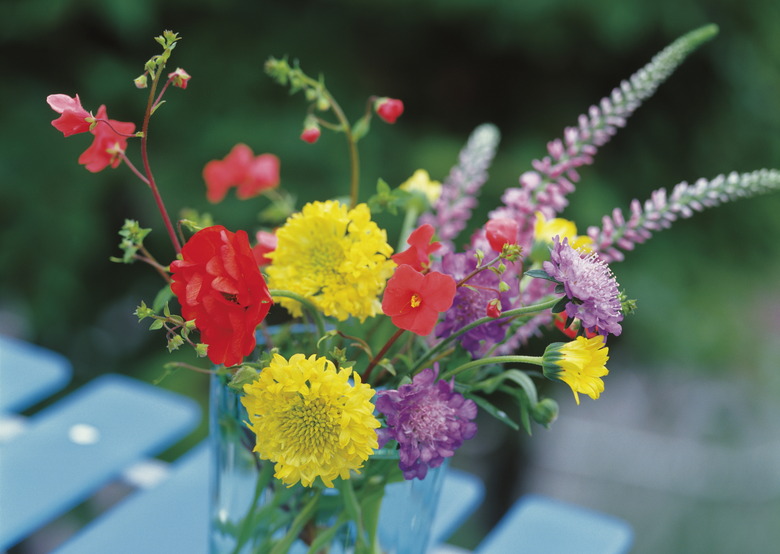Homemade Flower Food For Fresh-Cut Flowers
It can be disheartening to harvest fresh cut flowers from your garden, arrange them in a vase, and then watch your beautiful floral arrangements decline after only a day or two and start wilting. But there's a DIY hack you can use that's similar to something that florists have used for years.
Tip
You can make your own DIY floral preservative that is just as effective as any store-bought variety.
You've probably received flower food packets of floral preservative when receiving or purchasing commercial flower stems, even those from the grocery store. But if you're growing your own cut flowers, knowing how to make a homemade floral preservative, often called flower food, can extend the vase life of many flowers the same as commercial products do.
How Floral Preservatives Work
As long as flower stems are attached to the plants that produced them, the flowers on the stems receive water and nutrients from the plant's transport system. But as soon as flower stems are severed from plants, their source of water and nutrients is also severed.
Placing stems of cut flowers in water supplies part of their needs—water—but it doesn't supply their nutritional need. Working in tandem, water and nutrients allow most cut flowers to last longer in a vase than when they're placed solely in water.
Tip
Water alone won't help preserve cut flowers. They need nutrients as well.
An effective floral preservative replaces the nutrients that are lost when flowers are harvested from plants. Commercially packaged floral preservatives come in little packets, with brand names including FloraLife® and Chrysal®, which are crystals that dissolve in water.
When you don't have any of these products on hand, you can approximate their benefits by making your own using three ingredients in your DIY recipe.
Three Components of a Homemade Floral Preservative
The three essential components of a homemade floral preservative are:
- A carbohydrate food source
- A pathogen inhibitor known as a biocide, which kills harmful bacteria that shorten the vase life of flowers
- An acidifier to lower the pH level in the solution, which inhibits bacterial growth
Using pantry items you likely have on hand, use sugar as the carbohydrate food source, bleach as the biocide, and vinegar, lemon juice or even lemon-lime soft drinks as an acidifier.
Avoid Some Online Recommendations
Anecdotal recipes abound online for DIY homemade flower food, with ingredient recommendations that include adding copper pennies and/or aspirin for cut flowers. But neither of these ingredients, as well as a slew of other recommendations, are effective.
Warning
If you read that adding copper pennies to a floral preservation solution is effective, consider the change in the level of copper in pennies since 1982.
The prevailing theory behind adding copper pennies to the water is the notion that copper is a fungicide; in fact, many organic fungicides use copper as the active ingredient. But this recommendation falls short because the actual copper content of pennies has changed.
Prior to 1982, pennies were made of 95 percent copper. That composition drastically dropped after 1982 to less than 3 percent, comprising only a thin layer of coating. Even if you used a penny minted prior to 1982, the vase size, amount of water and time it would take for copper to dissolve in the water solution present too many variables for a blanket recommendation to add a certain number of pennies as an effective fungicide.
Three Homemade Floral Preservative Recipes
Consulting reputable sources online, chiefly those in academia, reveals a number of recommended recipes for homemade flower food. Here are three of them:
Flower Food Recipe #1
- 2 cups lemon-lime non-diet soft drink
- ½ teaspoon chlorine bleach
- 2 cups water
Flower Food Recipe #2
- 2 tablespoons white vinegar
- 2 tablespoons sugar
- ½ teaspoon chlorine bleach
- 1 quart water
Flower Food Recipe #3
- 2 tablespoons fresh lemon juice
- 1 tablespoon sugar
- ½ teaspoon chlorine bleach
- 1 quart water
Regardless of which recipe you choose, change the vase water daily with fresh solution to optimize flower freshness. Trim all leaves below the water line to keep them from rotting and contaminating the solution.
References
- University of Nebraska-Lincoln: Tips for Displaying Cut Flowers
- University of Massachusetts-Amherst: Sugar and Acidity in Preservative Solutions for Field-Grown Cut Flowers
- Southern Living: The Age of Your Penny Matters in Keeping Your Flowers Alive
- Purdue University Cooperative Extension Service: Add Hours to Your Flowers
